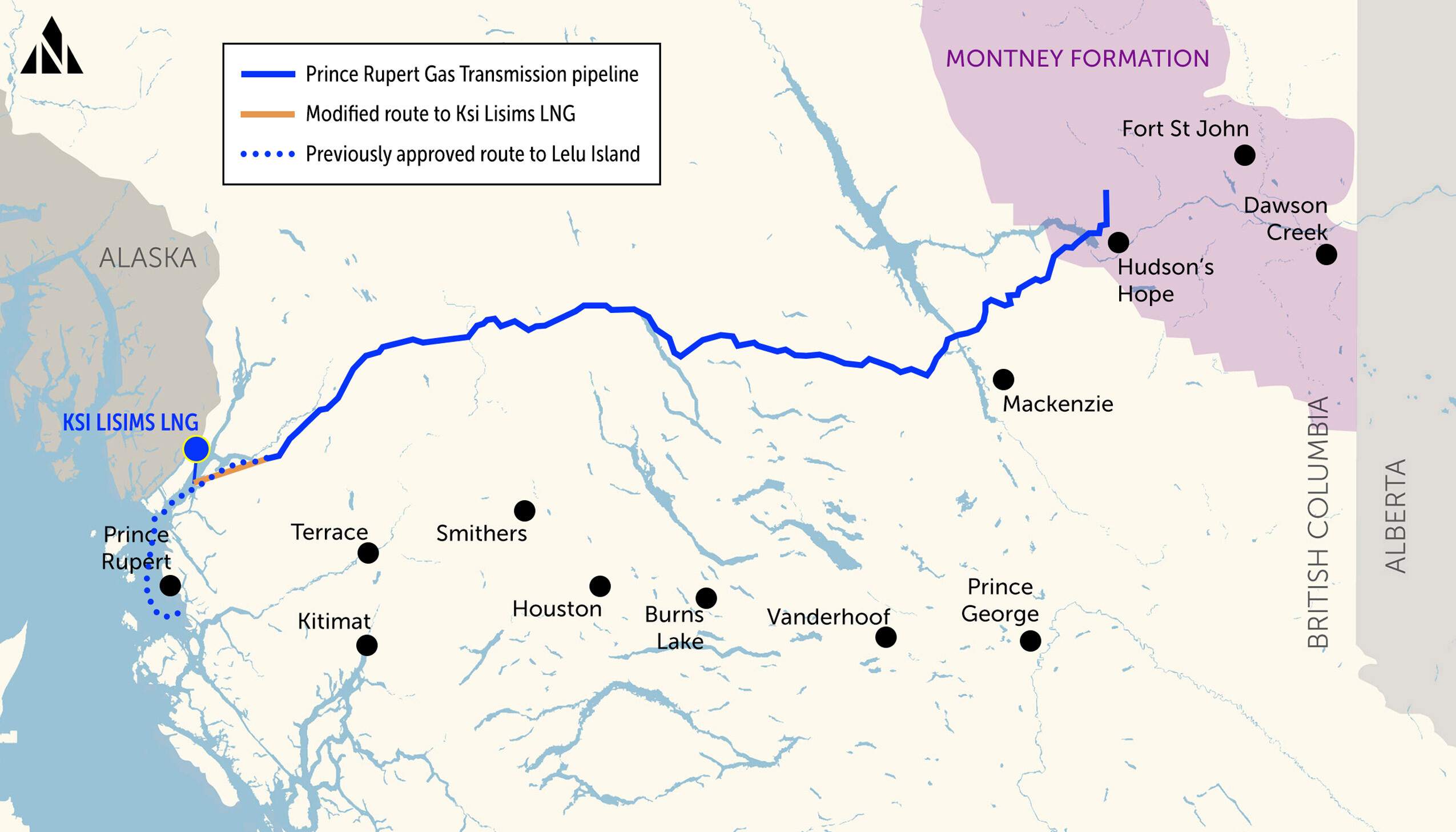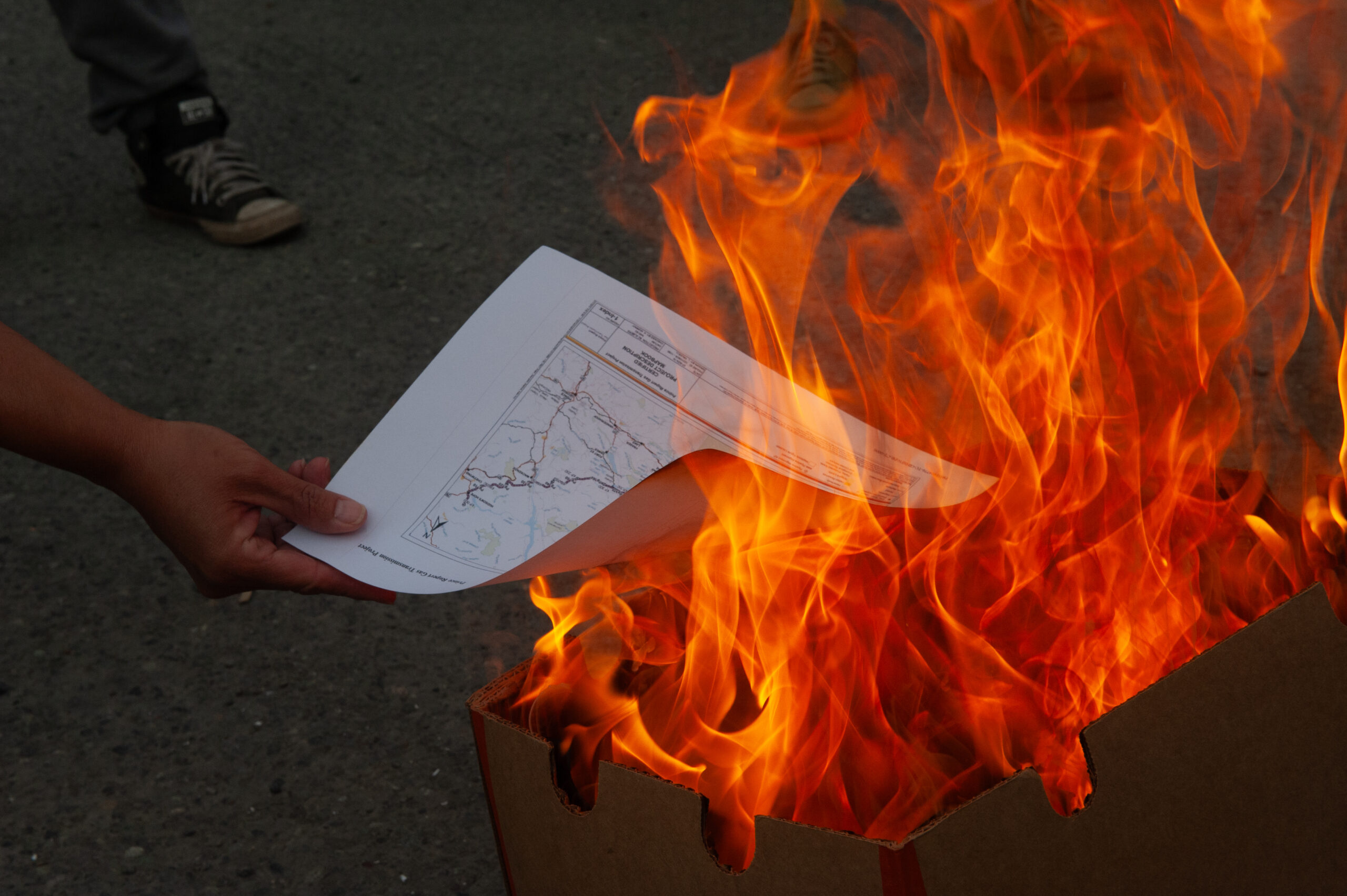
‘Afraid of the water’? Life in a city that dumps billions of litres of raw sewage into lakes and rivers
10 billion litres of sewage are dumped into Winnipeg’s lakes and rivers each year. Some...
Gitanyow Hereditary Chiefs have filed a new legal challenge against the British Columbia government over the proposed Ksi Lisims liquefied natural gas (LNG) facility in northwest B.C.
The chiefs submitted an application for judicial review to the B.C. Supreme Court on Oct. 25, alleging B.C.’s environmental assessment office failed in its duty to consult and is negligent in its obligations to protect fish species when it concluded the project does not pose a threat to Nass River salmon populations.
“This project threatens our food security and government has denied Gitanyow a role in decision making,” Simogyet (Hereditary Chief) Malii Glen Williams said in a statement.
The Nass River flows through Gitanyow lands from its origin in what’s known as the Sacred Headwaters, in Tahltan Nation territory. The river is home to five species of salmon. According to data published earlier this year, Nass River chinook and chum populations are a conservation concern and some sockeye populations are struggling. The Pacific Salmon Foundation’s 2024 state of salmon report notes the watershed’s largest sockeye population, which spawns in Meziadin Lake on Gitanyow territory, has “not met its spawning goal in six of the last 10 years.”
The Ksi Lisims project, co-owned by the Nisga’a Nation, is undergoing an environmental assessment.
If approved by the B.C. government, the floating natural gas liquefaction and export facility would be built near the Nass River estuary, in Nisga’a Nation territory, and would be capable of producing up to 12 million tonnes of LNG annually for export overseas.
The Nisga’a Lisims Government is a partner in the proposed project and co-owner of the pipeline that would supply the facility, the Prince Rupert Gas Transmission (PRGT) line. Its industry partners include Texas-based Western LNG and Rockies LNG Partners, a consortium of natural gas companies in B.C. and Alberta.
The Prince Rupert Gas Transmission pipeline will stretch 800 kilometres across northern B.C., from Treaty 8 territories in B.C.’s northeast that have been heavily impacted by the fracking industry to the mouth of the Nass River on the Pacific coast. It will be more than 100 kilometres longer than the Coastal GasLink pipeline.

“The government cannot ignore the undeniable connection between Gitanyow rights, the health of our salmon and the health and well-being of our future generations,” Malii said in his statement. “Current assessments for Ksi Lisims lack the specificity needed to understand how juvenile salmon, including those from key Gitanyow salmon populations, use critical habitats like bull kelp near the project site.”
The legal challenge details how Gitanyow Hereditary Chiefs engaged with B.C.’s environmental assessment office about the proposed project and alleges the provincial government is undermining its own environmental assessment process by determining the project will not impact Nass River salmon.
In March, Brennan Hutchison, oil and gas project assessment director with the environmental assessment office, wrote a letter to the chiefs denying their request to pause the environmental assessment process until further studies of the potential impacts on juvenile salmon could be conducted, according to the court documents.
Hutchison agreed the Nass River watershed is important “to Gitanyow and the ability of Gitanyow to have a food, social, ceremonial and economic fishery on the Nass mainstem and at Lax an Zok on the Meziadin River” but concluded “there is no reasonable possibility that Gitanyow or its [constitutionally protected] rights will be adversely affected by Ksi Lisims LNG.”
“This finding is entirely premature and is a blatant disregard for the watershed-wide impacts to salmon due to the proposed location of the Ksi Lisims LNG terminal that necessitates consultation and consent-based processes with all First Nations who have territories in the Nass River watershed,” Hup-Wil-Lax-A Kirby Muldoe, chair of the Gitxsan Lax’yip management office, said in a letter of support for the legal challenge.
The latest legal challenge follows mounting opposition to the Ksi Lisims LNG project and the PRGT pipeline, adding tension to growing conflict around fossil fuel development in B.C. and elsewhere.
In late August, as pipeline construction began on Nisga’a territory, Gitanyow Hereditary Chiefs burned agreements and set up a blockade to stop traffic related to the project from crossing their territory. A few days later, Indigenous and non-Indigenous groups launched legal action against the project, alleging the BC Energy Regulator broke its own rules to green light construction.
Both legal challenges question B.C. government processes. As the PRGT blockade got underway in late August, Gitanyow Hereditary Chiefs called for a new environmental assessment for the pipeline. The original assessment was conducted more than a decade ago. When the pipeline received government approval in 2014, B.C. gave a green light to a route ending in Prince Rupert. But the route was changed in an amendment application filed with the B.C. Environmental Assessment Office in June.
Instead of going to Prince Rupert, the pipeline’s proposed final destination is now the as-yet-unapproved Ksi Lisims LNG project on B.C.’s north coast, near Alaska. Gavin Smith, staff lawyer with West Coast Environmental Law, said the destination change calls into question whether the pipeline is the same project that was approved.
“Now we’re seeing, effectively, a different project being proposed that is going to an entirely different place,” Smith previously told The Narwhal. He said pipeline construction started this summer based on what appears to be an attempt to “portray and advance this through existing permits that were made for a project that was going to Prince Rupert.”

The pipeline’s environmental assessment certificate is set to expire on Nov. 25, unless the provincial government deems the project to have “substantially started.” That designation is given by B.C.’s environment minister based on the amount of construction completed, financial costs and other factors. It means the pipeline’s environmental assessment certificate — required for the project to proceed — remains valid instead of expiring. B.C.’s new environment minister will be appointed after the final provincial election results are known and a new cabinet is sworn in.
“Our rights and the health of our environment must not be sidelined for industrial interests,” Naxginkw Tara Marsden, Wilp sustainability director for the Gitanyow Hereditary Chiefs, said in a statement. “We call for transparency, proper consultation and rigorous assessments that genuinely consider the impacts on our community and at-risk ecosystems.”
Simogyet Watakhayetsxw Deborah Good, a Gitanyow Hereditary Chief whose territory would be crossed by the pipeline, said both the blockade and the legal challenge are focused on maintaining the health of the land, waters and wildlife for the next generations.
“Protecting the Nass River salmon is essential for our survival,” she said in a statement. “The land and waters are our sustenance and way of life — without them, we have nothing. We must return to the land to teach our youth the importance of safeguarding it, so future generations can experience the abundance it provides.”
Get the inside scoop on The Narwhal’s environment and climate reporting by signing up for our free newsletter. On a warm September evening nearly 15...
Continue reading
10 billion litres of sewage are dumped into Winnipeg’s lakes and rivers each year. Some...

Court sides with Xatśūll First Nation, temporarily halting Mount Polley mine waste expansion

Break out the champagne: Emma’s storied life and leadership in journalism has earned her the...
